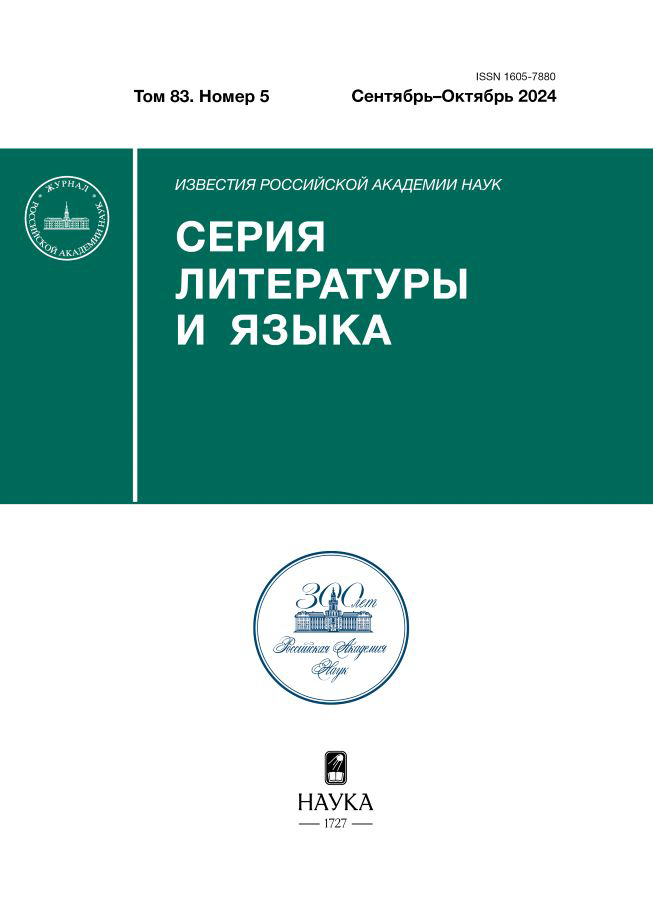Bestiary images in the autobiographical book “The Butterfly of Dinard” by Eugenio Montale
- Авторлар: Saburova L.E.1,2
-
Мекемелер:
- Russian State University for the Humanities
- A.M. Gorky Institute of World Literature of the Russian Academy of Sciences
- Шығарылым: Том 83, № 5 (2024)
- Беттер: 128-136
- Бөлім: Articles
- URL: https://rjonco.com/1605-7880/article/view/657045
- DOI: https://doi.org/10.31857/S1605788024050115
- ID: 657045
Дәйексөз келтіру
Аннотация
The article explores the typology of the bestiary presented in the stories from Eugenio Montaleʼs autobiographical book “The Butterfly of Dinard”, which the poet himself perceived as a whole work and called a “quasi-novel”. Montaleʼs prose and poetry are united by themes, ideological content, and imagery, so his poems serve as valuable commentary on the book “The Butterfly of Dinard”. Of particular interest is the poetʼs epistolary heritage, which helps to reveal the autobiographical basis hidden behind the fiction. In the story “Get a Taste”, the eel appears to the protagonist as a link to the world of nature, reviving memories of childhood. In the poetʼs work, the eel is associated with moments of epiphany, serving as a symbol of resilience. The story “Clizia in Foggia” contains a surrealist insert episode, the main characters of which are insects. The metamorphosis described in the story refers to the circumstances of the poetʼs personal life and is imbued with self-irony. In the story “The Bat”, the animal serves as a messenger from the other world. The characters in the story “Relics” view their past through the prism of relationships with animals, whom they perceive as a miracle of nature, givers of hope, and prophets pointing the way. In the story “Falling Ash”, the snail acts as a magical helper, prompting the right decision. In “The Butterfly of Dinard”, animals become guides to the world of memories and, moreover, intermediaries between the knowable and the transcendent.
Толық мәтін
Авторлар туралы
Liudmila Saburova
Russian State University for the Humanities; A.M. Gorky Institute of World Literature of the Russian Academy of Sciences
Хат алмасуға жауапты Автор.
Email: mila.saburova@gmail.com
Doct. Sci. (Philol.), Associate Professor at the Russian State University for the Humanities, Senior Researcher at the A.M. Gorky Institute of World Literature of the Russian Academy of Sciences
Ресей, 6 Miusskaya Sq., Moscow, 125993; 25a Povarskaya Str., Moscow, 121069Әдебиет тізімі
- Eugenio Montale. Immagini di una vita [a cura di Contorbia F.]. Milano: Librex A. Mondadori, 1985. 326 p. (In Italian)
- Montale E. Lettere a Clizia. [a cura di Bettarini R., Manghetti G. e Zabagli F.]. Milano: Mondadori, 2006. 376 p. (In Italian)
- Топорова А.В. Поэзия нового сладостного стиля // История литературы Италии: средние века. М.: ИМЛИ РАН, 2000. Т.1. С. 199–222. [Toporova, A.V. Poeziia novogo sladostnogo stilia [Poetry of a Sweet New Style]. Istoriia literatury Italii: srednie veka. T.1 [The History of Italian Literature: the Middle Ages. Vol. 1]. Moscow: IMLI RAN Publ., 2000, pp. 199–222. (In Russ.)]
- Segre C., Marcenaro G., Bettarini R., Zabagli F., Manghetti G. Le Lettere a Clizia di Eugenio Montale. Antologia Vieusseux. 2006, No. 3, pp. 5–29. (In Italian)
- Facchi F. Un “bestiario della memoria e del dolore”: gli animali nelle Lettere a Clizia di Eugenio Montale. Italica. 2016, No. 93, pp. 540–558. (In Italian)
- Montale E. Moscerilla diletta, cara Gina. Lettere inedite. Genova: Fondazione Giorgio e Lilli Devoto, 2017. 148 p. (In Italian)
- Senna P. Uno speciallissimo bestiario. Lʼindice dei libri del mese. 2017, No. 12, p. 29. (In Italian)
- Musumeci A. Il bestiario montalian. Italica. 1978, No. 55 (4), pp. 393–401. (In Italian)
- Montale E. “Ho scritto un solo libro” (1975). Montale E. Il secondo mestiere. Arte, musica, società [ a cura di Zampa G.]. Milano: Mondadori, 1996, pp. 1720–1725. (In Italian)
- Jacomuzzi A. La poesia di Montale. Dagli “Ossi” ai “Diari”. Torino: Einaudi, 1978. 182 p. (In Italian)
- Montale E. “Le reazioni di Montale”. Eugenio Montale: profilo di un autore [a cura di Cima A. e Segre C.]. Milano: Rizzoli, 1977, pp. 192–201. (In Italian)
- Orelli G. L’anguilla. Orelli G. Accertamenti montaliani. Bologna: il Mulino, 1984, pp. 79–94. (In Italian)
- Монтале Э. Динарская бабочка. Пер. с итал. Солоновича Е. М.: Река времен, 2010. 235 с. [Montale, E. Dinarskaia babochka Per. s ital. Solonovicha E. [The Butterfly of Dinard. Translated from the Italian by Solonovich E.] Moscow: Reka vremen Publ., 2010. 235 p. (In Russ.)]
- Segre C. Invito alla “Farfalla di Dinard”. Montale E. Prose narrative. Milano: Mondadori, 2008, pp. V–XXIII. (In Italian)
- Montale E. Tutte le poesie. [a cura di Zampa G.]. Milano: Meridiani Mondadori, 1990. 1245 p. (In Italian)
- Montale E. “Montale: io e la politica”. La Repubblica-Mercurio. 22 settembre 1990, p. 4. (In Italian)
- Bo C. Tra cielo e terra: viaggio attraverso i simboli animali della donna nella Bufera di Montale. Studi novecenteschi. 1990, No. XXXIX, pp. 103–129. (In Italian)
- Ландольфи Т. Отец Кафки // Жена Гоголя и другие истории. М.: Аграф, 1999. С. 338–340. [Landolfi, T. Otets Kafki [Kafkaʼs Father]. Landolfi, T. Zhena Gogolia i drugie istorii [Gogolʼs Wife and Other Stories]. Moscow: Agraf Publ., 1999, pp. 338–340. (In Russ.)]
- Montale E. Prose narrative. Milano: Mondadori, 2008. 532 p. (In Italian)
- Montale E. Prose e racconti [a cura e con introduzione di Forti M.]. Milano: Mondadori, 1995. 1253 p. (In Italian)
- Marcenaro G. Eugenio Montale. Milano: Mondadori, 1999. 213 p. (In Italian)
- Forti M. Montale: la prosa di fantasia e d’invenzione. Montale E. Prose e racconti [a cura e con introduzione di Forti M.]. Milano: Mondadori, 1995, pp. XI–XCIV. (In Italian)
- Casadei A. Montale. Bologna: Il Mulino, 2008. 149 p. (In Italian)
- Antonielli S. Eugenio Montale “Farfalla di Dinard”. Belfagor. 1961, No. 4, pp. 512–514. (In Italian)
Қосымша файлдар









